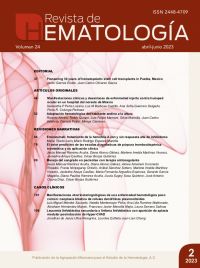Clinical manifestations and outcomes of ocular graft-versus-host disease in a hospital in northeast of Mexico.
Rev Hematol Mex. 2023; 24 (2): 46-51. https://doi.org/10.24245/rev_hematol.v24i2.8805
Samantha P Peña Lozano,1 Luz M Barbosa Castillo,1 Ana Sofía Guerrero Delgado,2 Perla R Colunga Pedraza1
1 Servicio de Hematología, Hospital Universitario Dr. José Eleuterio González, Monterrey, Nuevo León, México.
2 Facultad de Medicina.
Universidad Autónoma de Nuevo León, Monterrey, Nuevo León, México.
Resumen
OBJETIVO: Analizar la incidencia de enfermedad injerto contra huésped ocular en nuestro centro, su tratamiento y características, además del efecto de la enfermedad en la supervivencia de los pacientes.
MATERIALES Y MÉTODOS: Estudio observacional y retrospectivo, efectuado en pacientes mayores de 17 años con diagnóstico hematológico en los que se realizó un trasplante alogénico de células madre hematopoyéticas (aloTCPH) en el Hospital Universitario Dr. José E González, Nuevo León, México, de enero de 2015 a diciembre de 2021.
RESULTADOS: Un total de 204 pacientes se sometieron a aloTCPH, de ellos 83 pacientes manifestaron enfermedad injerto contra huésped en cierto punto y 22 (26.6%) de éstos padecieron enfermedad injerto contra huésped ocular (EICHo). Se observaron 9/22 pacientes con EICHo grado leve, 11/22 con moderado y 2/22 con severo. De los 22 pacientes, 10 recibieron esteroide sistémico, 6 ciclosporina oftálmica y 6 rituximab. La supervivencia global fue del 63% a 33 meses de seguimiento. Las manifestaciones clínicas fueron ojo seco, conjuntivitis, combinación de éstas y afectación de la córnea. No hubo diferencia significativa (p = 0.169) en la supervivencia ni en progresión del injerto ocular entre los pacientes que fueron valorados por oftalmología versus los que no.
CONCLUSIONES: No encontramos relación entre la supervivencia y progresión del injerto de los pacientes que manifestaron enfermedad injerto contra huésped ocular con el seguimiento solo por hematólogo o por un oftalmólogo.
PALABRAS CLAVE: Enfermedad injerto contra huésped ocular; tratamiento; trasplante; trasplante alogénico.
Abstract
OBJECTIVE: To analyze the incidence of ocular graft versus host disease in our center, its treatment and characteristics, besides the effect of the disease on survival of patients.
MATERIALS AND METHODS: An observational, retrospective study was carried out in patients older than 17 years with a hematological diagnosis in whom an allogeneic hematopoietic stem cell transplantation (allo-HSCT) was performed at the Hospital Universitario Dr. José E González, Nuevo Leon, Mexico, from January 2015 to December 2021.
RESULTS: A total of 204 patients underwent allo-HSCT of which 83 patients developed graft versus host disease (GVHD) at some point and 22 (26.6%) of these developed ocular graft versus host disease (oGVHD). We observed 9/22 patients with mild oGvHD, 11/22 with moderate and 2/22 with severe. Out of 22 patients, 10 received systemic steroid, 6 ophthalmic cyclosporine and 6 rituximab. Overall survival was 63% at 33-month follow-up. The clinical manifestations were dry eye, conjunctivitis, a combination of these and corneal involvement. There was no significant difference (p = 0.169) in overall survival or in ocular graft progression between patients who were assessed by ophthalmology versus those who were not.
CONCLUSIONS: We found no relationship between survival and graft progression of patients who presented with ocular graft versus host disease with follow-up only by a hematologist or by an ophthalmologist.
KEYWORDS: Ocular graft versus host disease; Therapeutics; Transplant; Allogeneic transplant.
Recibido: agosto 2023
Aceptado: septiembre 2023
Este artículo debe citarse como: Peña-Lozano SP, Barbosa-Castillo LM, Guerrero-Delgado AS, Colunga-Pedraza PR. Manifestaciones clínicas y desenlaces de enfermedad injerto contra huésped ocular en un hospital del noreste de México. Hematol Méx 2023; 24 (2): 46-51.

